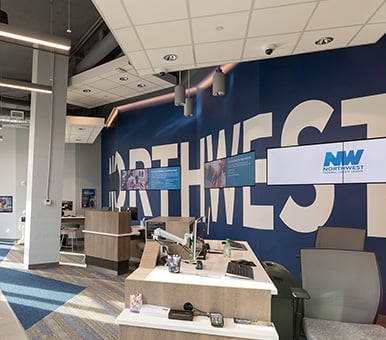
Artificial intelligence (AI) is beginning to transform financial institutions by offering enhanced customer experiences, improved fraud protection, and streamlined back-office processes.
If you’ve been paying attention to the media in 2023 or even have a slight pulse on the topics of interest right now, you probably heard a lot of news about AI and how it’s poised to change the entire face of business and industry. Along with that news, you’ve probably listened to a fair amount of speculation over the role it’s going to play in the workforce.
The fact is, AI comes with a vast array of benefits that can help businesses make better decisions, operate more efficiently, and achieve greater ROI. This article explores AI a little further and gives some examples of how it can be optimized in retail and commercial banking.
What is AI? And While We’re at It … What is ChatGPT
Artificial intelligence (AI) is the ability of a machine to perform intellectual functions like a human—things like reasoning, learning, problem-solving, and processing language. Through the utilization of specialized hardware and software, AI receives large amounts of data, analyzes it to decipher patterns and correlations, and then makes decisions or predictions based on what it’s gathered. Real-world applications of AI include machine learning, robotic process automation, machine vision, speech recognition, and more.
If you recognize the name ChatGPT, it’s probably because this AI chatbot gained over 100 million monthly users shortly after it was released by OpenAI in November 2022. ChatGPT uses machine learning and natural language processing to understand and generate human-like responses to questions as well as provide predictions and recommendations. So far, it has helped users with activities like education, content creation, marketing, sales, and programming. For now, ChatGPT is free to use on a basic level, while the Plus version is available by monthly fee.
How Can AI Be Used in Banking?
You may not realize it, but AI has been utilized in banking for some time already, especially since 2020 when the pandemic made mobile and online banking critical to service continuation. To that end, 56% of respondents in a 2021 McKinsey survey said they were using AI in at least one part of their banking operations at the time.
Looking ahead, many financial executives are considering how AI tools can help with digital transformation, especially as brick-and-mortar financial institutions find themselves increasingly competing with tech-savvy neo banks and other online financial service providers. Notably, 77% of bankers surveyed by The Economist Intelligence Unit said that the ability to unlock the value of AI is going to determine the success or failure of banks.
Want to know more? Here are some things AI is helping banks and credit unions do:
Provide Better Customer Service
AI helps the personalization process by gathering data from past interactions and then customizing banking products and services to meet a customer’s needs. This helps increase engagement, earn trust, and build better relationships. Besides helping customers directly, AI provides valuable insights into customer behavior so a financial institution can provide improved products and services as well as craft more targeted marketing and advertising campaigns.
On a more day-to-day basis, AI improves customer service through the use of virtual assistants (aka chatbots) that answer FAQs, provide service information, and give instructions for performing transactions. This not only provides customers with anytime access to basic banking functions, but it also frees up staff members so they can dedicate more time to high-level, advisory conversations.
Improve Transaction Security
Being front-loaded with historical customer data, the machine-learning algorithms of AI are able to identify unusual patterns in account activity and then flag suspicious activity much faster than manual processes are able to. This helps prevent crimes such as fraud, identity theft, and money laundering, therefore reducing long-term financial losses for both the customer and the financial institution.
Here's an example: A customer receives a text from their bank notifying them of a large credit card transaction in a city they have never visited, asking to verify the transaction. If the customer verifies the transaction, it continues processing. If not, the transaction is halted and the customer is prompted to contact their bank to explore a potential issue with their card. This is AI at work, providing real-time assistance to aid in preventing financial loss.
Enhance Back-Office Operations
Financial institutions are now utilizing AI solutions to assist in credit decisions, which means instead of determining creditworthiness based solely on credit risk models, a loan official can tap a well-built machine learning model to analyze a customer’s patterns and behaviors. This provides a fairer way to evaluate risk in lending, and in the end, delivers a stronger product to the customer.
Additionally, the use of AI reduces a large amount of manual labor for banking staff since it’s able to automate document processing through optical character recognition (OCR) technology and move financial data quickly and efficiently to the institution’s software system. This automation is able to improve the accuracy and speed of many repetitive tasks found in accounting, human resources, and general operations.
What are the Challenges Financial Institutions Face with AI?
A couple things come to mind as far as scaling a bank or credit union for AI. One is the fact that there’s going to be increasing competition from neobanks in the financial space—institutions which are usually several steps ahead of brick-and-mortar operations as far as technology advancement. Two is that banks and credit unions will need to keep managing the regulatory requirements and security standards of traditional financial services.
To work with these challenges, it’s important to first evaluate your bank or credit union’s strategic goals and how they can be improved by AI. From here, you’ll be able to identify areas to address and then develop a plan to integrate new technologies. Customer engagement, operating models, and core technologies are all critical elements to explore.
Prepare for the Future of AI
Adding AI to your financial institution’s infrastructure is a decision that will require some up-front time and dedication from your financial executives and IT staff. As industry leaders in design-build, DBSI can help you find resources to begin your digital transformation and then assist you in readying your operating models and core technologies for an AI-enhanced future.


































 Jared Jones
Jared Jones


